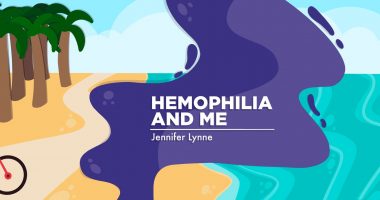Revisiting a Tragic Chapter in the History of Hemophilia and AIDS

I recently visited the small town of Arcadia, Florida, which is not far from my home. Arcadia holds an important place in history for the topic of hemophilia and AIDS. The story of what happened there is a lesson about how ignorance can fuel hatred and knowledge can fuel compassion.
In the 1980s, Arcadia was home to the Ray family: parents Clifford and Louise and their four children, Ricky, Robert, Randy, and Candy. Cliff and Louise were born and raised in Arcadia, as were generations of their family before them. The three boys were all born with severe hemophilia.

Arcadia, Florida, is known for its annual rodeo, seen here in 2017. (Photo by Jennifer Lynne)
HIV/AIDS
In 1986, at the ages of 8, 7, and 6, Ricky, Robert, and Randy, respectively, all tested positive for HIV, the virus that causes AIDS. Like many others at the time, they had contracted the virus from contaminated blood sourced from donors and used in the medication they took for hemophilia, as Louise explained in a 2016 video for the National Aids Memorial and HIV Story Project.
The boys had been given periodic infusions of factor VIII, a clotting factor made from human blood. The blood of thousands of donors was used to create a single dose of factor. Before doctors knew of the existence of HIV, it had slipped into the national blood supply and the medication.
Because they had tested positive for HIV, the Ray brothers were banned from attending school by the DeSoto County School Board, as several news outlets reported at the time. Many parents in this rural community, whose population at the time was about 6,500, feared their children would be exposed to HIV, despite assurances from health experts that a school or similar environment posed no risk.
According to the Associated Press, angry parents distributed petitions and sponsored rallies to keep the boys out of school and called for a boycott if the boys did attend school.
The Ray family also was asked not to attend their church. They received death threats, and the local barber even refused to cut their hair. According to The Washington Post, bomb threats closed the local elementary school several times. Parents marched in public protest and withdrew their children from classes.
In response, the Ray family sued the DeSoto County School Board and won, clearing the way for the boys to return to school.
Education
In 1987, just a week before school was to start, an arsonist burned down the Ray family’s home. Most of the family wasn’t home at the time of the fire, but an uncle of the boys was asleep in a bedroom and was treated for smoke inhalation.
In the National Aids Memorial and HIV Story Project video, Randy described the family’s ordeal: “We had no friends at all. All we had was each other. We didn’t have anything anymore. I received death threats when my brothers were in the hospital dying. I didn’t understand why people would want to kill us. We were just kids. We didn’t do anything to cause us to deserve having AIDS or HIV.”
The fire received global attention and became a keystone event in the history of AIDS in the U.S. by helping to transform society’s views of the illness and its victims. The sheer cruelty the Ray family experienced, which turned their lives upside down, prompted them to become activists.
“Things changed so much for us around the country after the Ray family. People saw that education is really an imperative in dealing with AIDS,” Alan Brownstein, executive director of the National Hemophilia Foundation, told the Miami Herald in 1992. “They went through hell, but their hell has helped others.”
After the fire, the Rays left Arcadia and moved to Sarasota, Florida, where they were welcomed into the community. According to the newspaper, Ricky spoke frankly about the disease with his new classmates.
Ricky Ray Relief Fund Act
Ricky, the oldest of the brothers, died in 1992 from complications relating to AIDS and hemophilia at the age of 15. Before that, he traveled across the country to speak candidly about the disease.
According to POZ magazine, Ricky wrote letters to U.S. presidents Ronald Reagan and George H.W. Bush asking them to increase funding for AIDS research. After Ricky died, President Bill Clinton wrote the Ray family, vowing that Ricky’s voice “will be remembered.” The president told the family that he kept Ricky’s picture on his desk. Clinton later presented Ricky with a posthumous award for his AIDS activism.
In 1988, U.S. lawmakers passed the Ricky Ray Relief Fund Act, which provided payments of $100,000 to people with blood-clotting disorders, including hemophilia, and who contracted HIV through the use of tainted products. The law also provided payments to those who contracted HIV from these individuals, such as a spouse or a child.
According to the AP, Robert, the middle brother, died in 2000 from complications of AIDS and hemophilia at the age of 22.
The youngest brother, Randy, is married and currently lives in Florida. In 2016, he remarked that he was having more joint bleeds due to hemophilia as he got older, but his health was good at the time.
“I don’t think the blood supply would be as safe as it is without the hemophilia community and all of the sacrifices and all of the hard work they have put in it,” he said in the video.
The story of the Ray brothers is painful. When I visited the quiet little town of Arcadia, it was hard for me to believe that people could have been so cruel. But that was a long time ago. At a national level, at least, things have improved since then. Let’s make sure to continue that momentum and honor the Ray family’s legacy.
Note: Hemophilia News Today is strictly a news and information website about the disease. It does not provide medical advice, diagnosis, or treatment. This content is not intended to be a substitute for professional medical advice, diagnosis, or treatment. Always seek the advice of your physician or another qualified health provider with any questions you may have regarding a medical condition. Never disregard professional medical advice or delay in seeking it because of something you have read on this website. The opinions expressed in this column are not those of Hemophilia News Today or its parent company, BioNews, and are intended to spark discussion about issues pertaining to hemophilia.








Comments
Tiffany Elliott
I've been reading more of this over the years. In November 2019, while doing research for another project (just finishing it up), I came across the HIV genocide of those with hemophilia when I picked up Bob Massie's A Song in the Night. The book not only broke my own trauma bond to the fascist Right but allowed me to do a bit more reading on this hidden (IMO deliberately) truly tragic chapter in disability history. I've since read Blood on their Hands, Eric Weinberg, Donna Shaw and Blood, Douglas Starr, Five Pints Bill Hayes. This chapter isn't told enough. To me, this is a crime that must be rectified.
Jennifer Lynne
There is also this documentary - Bad Blood: a Cautionary Tale on Amazon. https://www.amazon.com/Bad-Blood-Cautionary-Marilyn-Ness/dp/B00E94S2FS
Jennifer Lynne
Hi Tiffany - thank you for your comment. I am going to research the books and authors you have suggested. Indeed this is a low point in history and a story that is often not told. We must keep telling the story, so folks like the Ray family and so many others will not be forgotten.